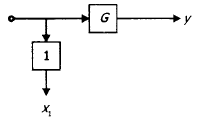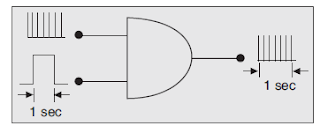(A) Choose the correct answer: 2 x 5
1. The transfer function of a system is G(s) = 10/(1 + s). The steady-state error to unit step input when operated at unity feedback system is
(a) 10
(b) 0
(c) 1/11
(d) 10
2. Sphere gaps are used for the measurement of
(a) Instantaneous values of voltage
(b) r.m.s. values of voltage
(c) Peak values of voltage
(d) Overage values of voltage
3. The inductance of low Q can be measured by using
(a) Schering Bridge
(b) Anderson’s Bridge
(c) Hay’s Bridge
(d) De Sauty’s Bridge
4. An average responding rectifier type electronic ac voltmeter has its scale calibrated in terms of the RMS value of a sine wave. If a square wave voltage of peak amplitude of 100 V is measured using this voltmeter, what will be the reading indicated by the meter?
(a) 200V
(b) 100 V
(c) 111 V
(d) 100√2V
5. The given block diagram is equivalent to
Answers
1. (c) 
2. (c) a spark gap can be used for measurement of the peak value of the voltage if the gap distance is known.
3. (b)4. (c) 
5. (b)
(B) Write short notes on any two: 2 x 5
Dynamometer type instruments and their uses
The electrodynamometer is a transfer-type instrument. A transfer-type instrument is one that may be calibrated with a dc source and then used without modification to measure AC. This requires the transfer type instruments to have the same accuracy for both DC and AC.
These instruments are also called Electrodynamic or Dynamometer Type Instruments.
An electrodynamic instrument is a moving-coil instrument in which the operating field is produced, not by a permanent magnet but by another fixed coil. This instrument can be used either as an ammeter or a voltmeter but is generally used as a wattmeter.
These are of following types
- Electrodynamic Ammeter
- Electrodynamic Voltmeter
- Electrodynamic Wattmeter
Frequency meter
frequency meter, device for measuring the repetitions per unit of time (customarily, a second) of a complete electromagnetic waveform. Various types of frequency meters are used. Many are instruments of the deflection type, ordinarily used for measuring low frequencies but capable of being used for frequencies as high as 900 Hz. These operate by balancing two opposing forces. Changes in the frequency to be measured cause a change in this balance that can be measured by the deflection of a pointer on a scale. Deflection-type meters are of two types, electrically resonant circuits and ratiometers.
Digital frequency meter System
The signal is converted to trigger pulse and applied continuously to an AND gate, as shown in
the following figure. A pulse of 1s is applied to the other terminal, and the number of pulses counted during this period indicates the frequency.
The frequency of the signal is converted into a train of pulse for each cycle of the signal. The number of pulses occurring in a definite interval of time is then counted by an electronic counter. Since each pulse represents the cycle of the unknown signal, the number of counts is a direct indication of the frequency of the signal (unknown).
Masons’ gain formula and signal flow graph
To find the transfer function of a complicated system of block diagrams, the reduction technique is a cumbersome process because the step-by-step reduction of the block diagram is required. On the other hand, it is possible to obtain the transfer function (TF)n very easily by using Mason's gain formula given below:
where
N = total number of the forward paths
P. = gain of the ith forward path
△ = value of after eliminating all loops that touch its forward path.
Nyquist stability criterion
A closed-loop control system having an open-loop transfer function G(s)H(s) will be stable if and only if
N = -P₀
where
N = Number of counter-clockwise encirclements about (-1, 0) point in the G(s)H(s) plane
P₀ = Number of poles G(s)H(s) in the RHP.
If N > 0, the system is unstable with the number of zeros of 1 + G(s)H(s) in RHP Z = N + P₀
If N ≤ 0, i.e., (-1, 0 ) is not enclosed, the system is stable only for N = 0 and P = 0 or N = - P₀
Synchros as torque transmitter
- The synchro transmitter converts the angular position of its rotor (mechanical input) into an electrical output signal.
- When a 115-volt ac excitation voltage is applied to the rotor of a synchro transmitter, the resultant current produces an ac magnetic field around the rotor winding.
- The lines of force cut through the turns of the three stator windings and, by transformer action, induce voltage into the stator coils.
- The effective voltage induced in any stator coil depends upon the angular position of that coil's axis with respect to the rotor axis.
- When the maximum effective coil voltage is known, the effective voltage induced into a stator coil at any angular displacement can be determined.
Gyroscope and its use
A gyroscope is an instrument used in space ships and aircraft. The input is the angular velocity and the output is the angular displacement.
The action of the gyroscope is based on the following two physical principles:
- If no external torque acts on it, the spinning wheel maintains the direction of its spin axis in space, and this type of spinning is known as the free gyro type.
- If torque is applied to an axis inclined to the spin axis of a wheel, the wheel rotates about an axis at an angle of 90° to both the spin axis as well as the input torque axis. This type of rotation is known as the precision type.
Applications of Gyroscope
- Gyroscopes find applications in the compasses of boats, spacecraft, and aeroplanes. The orientation and the pitch of the aeroplane are determined against the steady spin of the gyroscope.
- In spacecraft, the navigation of the desired target is done with the help of a gyroscope. The spinning centre of the gyroscope is used as the orientation point.
- The stabilization of the large boats and satellites is done with the help of massive gyroscopes.
- Gyroscopes are used in gyrotheodolites for the maintenance of the direction in tunnel mining.
- Gyroscopes along with accelerometers are used in the design of smartphones providing excellent motion sensing.
---
- The study material for AMIE/B Tech/Junior Engineer exams is available at https://amiestudycircle.com
- If you like the post please share your thoughts in the comment section










Comments